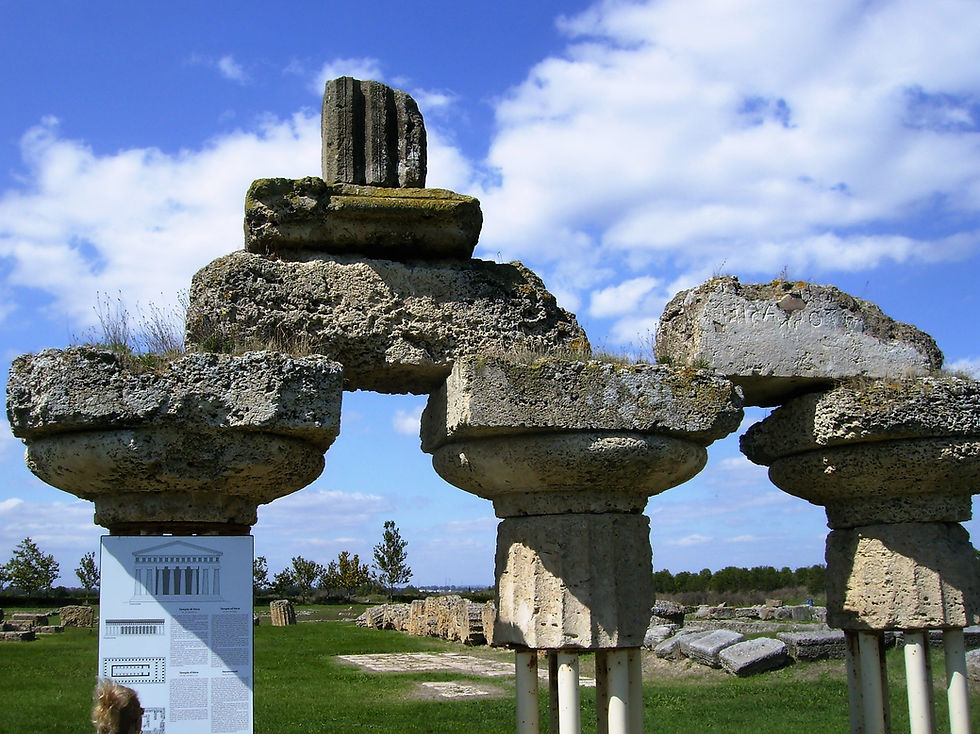Basilicata: many villages to visit
- Angelo e Adele
- Apr 14, 2021
- 3 min read
Updated: Dec 19, 2022
A few years after our post on Melfi area, we return to Basilicata to take a look at a series of small suggestive villages, mostly accessible by our means. We visited them at the time, in September 2010, but the information we will provide you should still be applicable. So let's start with two small municipalities, which are often mentioned together, as they are sites facing each other. We are talking about Castelmezzano and Pietrapertosa, two mountain villages set in the frame of the Lucane Dolomites (http://dolomitilucane.it/), an Apennine massif with very particular shapes that belongs to the Regional Park of Gallipoli, Cognato and Piccole Dolomiti. Their history dates back to the 6th - 7th century BC, to the Greeks and the Pelasgians; today they are joined by a common tourist destination, as well as by an overhead line that allows individuals appropriately harnessed to descend from Pietrapertosa to Castelmezzano by sliding on a cable at high speed and thus creating the so-called "flight of the angel". Castelmezzano (the only one of the two whose streets we walked):






Pietrapertosa (the highest town in Basilicata, over 1000 meters):


And after the two very small villages of the Lucanian Dolomites, we move on to a town of 10,000 inhabitants, Montescaglioso, whose roots go back as far as 1000 BC. Here too we were able to move with our own means, for a large part of the territory of the municipality, including the car. Let's take a look at the village:


But the highlight, so to speak, of Montescaglioso is the Abbey of San Michele Arcangelo. Dating back to the Norman era (11th century), it was rebuilt in 1484 and had a second flowering period until 1784, when the Benedictine monks moved to Lecce due to conflicts with the feudal lord of the time. Some pictures of one of the cloisters:






Not far from Montescaglioso is Miglionico, another ancient village dating back to around the eighth century BC Here we limited ourselves to visiting the courtyard of the Malconsiglio Castle, so called by the conspiracy of the barons, hatched in 1485 by a group of feudal lords against Ferrante I of Aragon. The plot ended badly for the conspirators, who were lured to Naples by deception and captured in the Sala dei Baroni of the Maschio Angioino, after which they were put to death. For further news and virtual visits see the website http://www.castellodelmalconsiglio.it/7m/?jjj=1618474923971:




We move towards the Ionian coast and go to visit an important archaeological site. We are talking about Metaponto, the Achaean colony founded at the end of the 6th century BC. between the mouths of the Bradano and Basento rivers, which became in 272 BC. partner of the Romans who occupied it definitively after he had sided with Hannibal. Today we can visit the remains of the city in the Archaeological Park of Metapontino (http://www.archeobasilicata.beniculturali.it/WA_Musei_Archeologi.aspx?pagina=Metaponto) and in the related National Archaeological Museum, which unfortunately we could not visit. Some pictures of the Archaeological Park:

The Roman tombs:

The sacred enclosure (temenos):

The Temple of Hera:


Temple D:

From classical archeology we pass to the archeology of the '900. What is it about? We are talking about the ghost town of Craco Vecchia, which suddenly appears before your eyes as soon as you turn a curve of the S.S. 103. Starting from 1963 Craco was abandoned by the inhabitants, who moved further downstream to the new municipality of Craco Peschiera. The cause? A landslide, the latest in a series of landslides that characterized the entire twentieth century. After the abandonment, the town was also used as a film set in important films such as The Passion of Christ by Mel Gibson, Christ stopped at Eboli by Francesco Rosi, Nymph plebeian by Lina Wertmuller, Basilicata coast to coast by Rocco Papaleo and many others. Today the ghost town can be known inside with appropriate guided tours; we are not sure, however, if there are any suitable for those who travel in a wheelchair. So we limit ourselves to showing you some photos from the outside, photos that still give the idea of the spectrality of the place:





To close, a few words about the structure that hosted us. It is a farmhouse inserted in a large green space with very extensive paths and meadows. The structure also sells typical products of its own making (dried tomatoes, artichokes, aubergines, extra virgin olive oil, etc.): L'orto di Lucania: Contrada Dogana, SP 175 km 13.2 Montescaglioso (MT) + 39 333 9802592 https://www.ortodilucania.it/




Comments